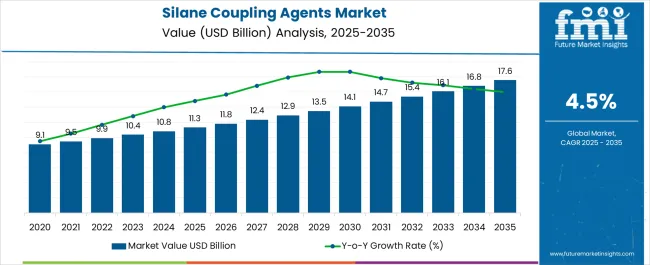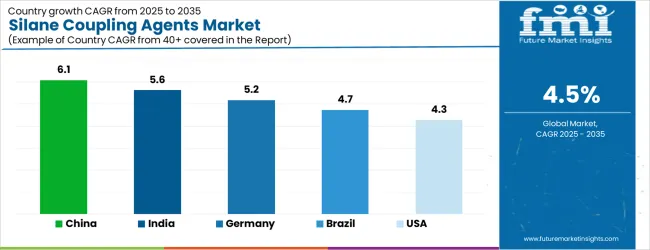The Silane Coupling Agents Market is estimated to be valued at USD 11.3 billion in 2025 and is projected to reach USD 17.6 billion by 2035, registering a compound annual growth rate (CAGR) of 4.5% over the forecast period.

| Metric | Value |
|---|---|
| Silane Coupling Agents Market Estimated Value in (2025 E) | USD 11.3 billion |
| Silane Coupling Agents Market Forecast Value in (2035 F) | USD 17.6 billion |
| Forecast CAGR (2025 to 2035) | 4.5% |
The Silane Coupling Agents market is experiencing strong growth, driven by the increasing demand for enhanced adhesion, durability, and performance in composite materials and coatings across multiple industries. These agents are being adopted to improve compatibility between organic polymers and inorganic substrates, which enhances mechanical properties, chemical resistance, and longevity of end products. Growth is further supported by rising applications in adhesives, sealants, paints, and elastomers, as well as in construction, automotive, and electronics sectors.
Advances in formulation technologies and eco-friendly chemistries are allowing manufacturers to develop high-performance, low-emission silane coupling agents that comply with stringent environmental regulations. The demand for lightweight, high-strength materials in construction and industrial applications is also contributing to market expansion.
As manufacturers focus on product quality, performance, and sustainability, silane coupling agents are being increasingly integrated into value-added applications Rising investments in infrastructure, industrial modernization, and durable material adoption are expected to sustain long-term growth, positioning the market for continued expansion over the coming decade.
The silane coupling agents market is segmented by product type, end-use industry, and geographic regions. By product type, silane coupling agents market is divided into Aminosilane, Vinylsilane, Acryloxy, Epoxysilane, and Others. In terms of end-use industry, silane coupling agents market is classified into Construction, Chemicals, Electrical, Automotive, and Energy. Regionally, the silane coupling agents industry is classified into North America, Latin America, Western Europe, Eastern Europe, Balkan & Baltic Countries, Russia & Belarus, Central Asia, East Asia, South Asia & Pacific, and the Middle East & Africa.

The aminosilane product type segment is projected to hold 28.4% of the market revenue in 2025, establishing it as the leading product type. Its growth is driven by the ability to improve adhesion between polymer matrices and inorganic substrates, which is critical for high-performance coatings, adhesives, and composite materials. Aminosilane enhances mechanical strength, chemical resistance, and thermal stability, making it preferred in industrial applications where durability and longevity are required.
Increasing focus on lightweight and reinforced materials, particularly in construction and automotive applications, is further strengthening adoption. The segment is supported by advancements in formulation technologies that enable environmentally compliant and low-emission products.
Its compatibility with a wide range of polymers and inorganic fillers ensures versatility across multiple end-use industries Continuous investments in research and development, along with growing awareness about material performance enhancement, are expected to maintain the leadership of the aminosilane segment, ensuring its continued contribution to overall market growth.

The construction end-use industry segment is expected to account for 33.7% of the market revenue in 2025, making it the leading end-use sector. Growth in this segment is being driven by the increasing demand for durable, high-performance building materials, such as concrete, coatings, sealants, and adhesives, which rely on silane coupling agents to improve adhesion, moisture resistance, and structural stability. The rising adoption of sustainable construction practices and advanced composite materials is further accelerating market penetration.
Silane coupling agents enhance mechanical strength and chemical resistance of building materials, ensuring longer service life and reduced maintenance costs. Investment in infrastructure projects, urban development, and industrial construction is supporting consistent demand.
Additionally, the focus on lightweight, reinforced, and eco-friendly materials is driving increased incorporation of silane coupling agents into construction applications As industry requirements evolve and performance standards become more stringent, the construction sector is expected to continue driving the growth of the silane coupling agents market while reinforcing its position as the largest end-use contributor.
Silane coupling agents are compounds whose end molecules have functional groups, which can react and result in bond formation with organic and inorganic compounds. Commercially, silane coupling agents are commercially available with different functional groups, such as expoy, vinyly, acryloxy, amino and many other groups, which enable various functions of silane coupling agent compound to be used in applications, such as resin modification and surface treatment.
With the ability of forming bonds with organic and inorganic materials, the silane coupling agent is a material of choice that provides improved mechanical strength to a composite material. Also, silane coupling agent has exceptional resulting properties, such as better heat resistance, water resistance, improved weather ability and improved durability of resin.
Pertaining to these exceptional properties, silane coupling agent finds its adoption in different applications in industries such as chemical, automotive, electrical, energy and construction. The chemical industry predominantly adopted silane coupling agents for improving transparency and viscosity during mixing and kneading.
In the construction industry, silane coupling agents are generally used to improve the strength and durability of exterior walls, buildings and other structures for a long term. The automotive segment uses silica-reinforced tyres with relatively high molecular weight, which can withstand with the challenging weather conditions.
The chemical and automotive industries are expected to remain the major industries using silane coupling agents for their applications. Most of the key players are working in the formulation of silane coupling agents, who hold the maximum market share.
Over the next ten years, the increasing activities to develop new products coupled with growing implementation of novel technologies for accomplishing better operating efficiency and productivity have facilitated the competitive universe.

| Country | CAGR |
|---|---|
| China | 6.1% |
| India | 5.6% |
| Germany | 5.2% |
| Brazil | 4.7% |
| USA | 4.3% |
| UK | 3.8% |
| Japan | 3.4% |
The Silane Coupling Agents Market is expected to register a CAGR of 4.5% during the forecast period, exhibiting varied country level momentum. China leads with the highest CAGR of 6.1%, followed by India at 5.6%. Developed markets such as Germany, France, and the UK continue to expand steadily, while the USA is likely to grow at consistent rates. Japan posts the lowest CAGR at 3.4%, yet still underscores a broadly positive trajectory for the global Silane Coupling Agents Market. In 2024, Germany held a dominant revenue in the Western Europe market and is expected to grow with a CAGR of 5.2%. The USA Silane Coupling Agents Market is estimated to be valued at USD 4.0 billion in 2025 and is anticipated to reach a valuation of USD 4.0 billion by 2035. Sales are projected to rise at a CAGR of 0.0% over the forecast period between 2025 and 2035. While Japan and South Korea markets are estimated to be valued at USD 528.7 million and USD 323.9 million respectively in 2025.
| Item | Value |
|---|---|
| Quantitative Units | USD 11.3 Billion |
| Product Type | Aminosilane, Vinylsilane, Acryloxy, Epoxysilane, and Others |
| End-Use Industry | Construction, Chemicals, Electrical, Automotive, and Energy |
| Regions Covered | North America, Europe, Asia-Pacific, Latin America, Middle East & Africa |
| Country Covered | United States, Canada, Germany, France, United Kingdom, China, Japan, India, Brazil, South Africa |
| Key Companies Profiled | DuPont, KH Chemicals & Cosmetics Co., Ltd., BASF SE, TORAY Industries, Inc., AkzoNobel N.V., Momentive, Dow, Shin-Etsu Chemical Co Ltd, Evonik Industries AG, and Wacker Chemie AG |
The global silane coupling agents market is estimated to be valued at USD 11.3 billion in 2025.
The market size for the silane coupling agents market is projected to reach USD 17.6 billion by 2035.
The silane coupling agents market is expected to grow at a 4.5% CAGR between 2025 and 2035.
The key product types in silane coupling agents market are aminosilane, vinylsilane, acryloxy, epoxysilane and others.
In terms of end-use industry, construction segment to command 33.7% share in the silane coupling agents market in 2025.






Full Research Suite comprises of:
Market outlook & trends analysis
Interviews & case studies
Strategic recommendations
Vendor profiles & capabilities analysis
5-year forecasts
8 regions and 60+ country-level data splits
Market segment data splits
12 months of continuous data updates
DELIVERED AS:
PDF EXCEL ONLINE
Silanes Market Growth - Trends & Forecast 2025 to 2035
Chlorosilane Market Size and Share Forecast Outlook 2025 to 2035
Market Share Insights of Leading Trichlorosilane Providers
Tetraethoxysilane Market Size and Share Forecast Outlook 2025 to 2035
Dimethyldichlorosilane Market Size and Share Forecast Outlook 2025 to 2035
Coupling Agent (Compatibilizer) for Polypropylene Market
Fluid Couplings Market Analysis - Size, Growth, and Forecast 2025 to 2035
Dry Gas Coupling Market Analysis Size and Share Forecast Outlook 2025 to 2035
Diaphragm Coupling Market Growth - Trends & Forecast 2025 to 2035
Industrial Coupling Market Growth - Trends & Forecast 2025 to 2035
Automotive Coupling Market
Fifth Wheel Coupling Market Growth – Trends & Forecast 2025 to 2035
Elastomeric Couplings Market
Flexible Shaft Couplings Market
Automotive Disc Couplings Market Growth - Demand, Trends & Forecast 2025 to 2035
Torque Limiting Couplings Market
Automotive Driveshaft Couplings Market
Aircraft Drive Shaft And Couplings Market
Intelligent Torque Controlled Coupling (ITCC) Market
Matting Agents Market Size and Share Forecast Outlook 2025 to 2035

Thank you!
You will receive an email from our Business Development Manager. Please be sure to check your SPAM/JUNK folder too.
Chat With
MaRIA